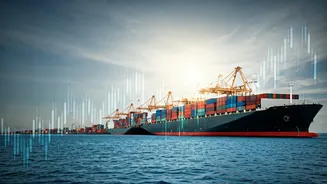Tariffs' Shifting Sands
Tariffs, essentially taxes on imported goods, have the potential to significantly impact various sectors. Historically, governments have used tariffs for
multiple objectives, including protecting local industries and promoting domestic employment. These tariffs raise costs for businesses that import goods, affecting profitability and ultimately, stock prices. It’s crucial to understand how tariffs can reshuffle business operations. Some sectors, heavily reliant on imports, are more susceptible. Others, particularly those with strong domestic supply chains or export-oriented strategies, might experience fewer direct effects, potentially becoming attractive investment options. The impacts often cascade, influencing pricing, consumer behavior, and overall economic growth rates. Investors looking to navigate tariff-related market changes must carefully analyze company-specific strategies and sector dynamics. These dynamics also influence the relative appeal of various investment options.
Sectoral Impact Overview
The degree to which businesses and industries are affected by tariffs is a critical consideration. The effects are not evenly distributed. Sectors that have high import costs or that heavily export are often most exposed to the effects of tariffs. For example, the automobile industry, reliant on global supply chains for components, might face escalating production costs. On the other hand, the technology sector, with its complex global value chains, could see disruptions in the availability of essential components. Agricultural sectors, where products are subject to trade disputes, might experience price fluctuations that can cause challenges for producers. Retail and consumer goods businesses might face higher prices for imported products, potentially affecting sales volumes and profit margins. Understanding these dynamics is essential for assessing investment risks and opportunities. Some sectors might face short-term hurdles, while others could find innovative strategies to adjust. The impact of tariffs frequently extends across multiple industries, creating a need for broad, cross-sector analysis.
Stock Selection: Key Factors
When assessing stocks for tariff impacts, several factors need careful consideration. First, the extent of a company's reliance on imported inputs is important. Businesses that import a large percentage of raw materials or components may have a higher risk. Secondly, the market's geographic footprint matters. Companies that are heavily involved in international markets, either through exports or international sales, might be particularly vulnerable to trade policy changes. Third, companies' pricing power is a key determinant. Those with the flexibility to pass on higher costs to consumers might weather tariffs better than those lacking this flexibility. Fourth, the degree of sector-specific regulatory factors influences how firms respond. Finally, investors should assess management strategies. Strong, flexible management teams can adapt to tariffs by altering sourcing, diversifying markets, or optimizing supply chains. Evaluating these factors creates a framework for identifying companies that are more or less sensitive to changes in trade policy.
Automotive Sector Stocks
The automotive sector is often profoundly impacted by trade tariffs, as it relies on complex global supply chains. Tariffs on imported components, such as semiconductors, steel, and aluminum, can immediately raise manufacturing expenses. This scenario directly influences the cost of producing cars and can affect profitability margins. If tariffs are implemented, automakers might respond by reducing production volumes, raising vehicle prices, or rethinking supply chain strategies. Tactical investors should evaluate businesses with strong domestic supply chains or those with robust export strategies. Companies that manufacture electric vehicles could experience different tariff implications due to differing supply chain dynamics. Investment evaluations should include assessing the adaptability of firms to tariff-related changes, their pricing capabilities, and their long-term growth prospects. The strategic decisions made by automotive manufacturers, such as moving production facilities or securing alternative supply chains, will also impact stock performance.
Technology Sector Implications
Technology companies operate within complex global value chains, making them vulnerable to trade restrictions. Tariffs on semiconductors, electronic components, and finished goods, can result in increased costs. Furthermore, policies can lead to supply chain disruptions, impacting the ability of companies to manufacture and deliver products efficiently. This is particularly challenging for businesses that manufacture goods that are both imported and exported. Investors should carefully analyze businesses' strategies for managing supply chain risks, their market diversification, and their ability to adapt to changes in trade rules. Firms engaged in software development, cloud computing, and other service-based activities might be less directly affected. However, they are still prone to indirect impacts, such as slowing economic growth or shifts in consumer behavior. It is important to look at businesses with strong research and development capabilities, that can innovate and maintain a competitive advantage in a changing market.
Agricultural Sector Analysis
The agricultural sector is especially sensitive to tariffs, particularly when these are used as tools in trade conflicts. Tariffs on imported agricultural inputs, such as fertilizers and machinery, can increase costs for producers, potentially diminishing profit margins. Furthermore, tariffs on agricultural exports can substantially impede sales in international markets. This might result in a decrease in crop prices and the overall economic wellbeing of farmers. Investors should investigate companies that are involved in diversified markets and companies with flexible supply chains, and those that have strong domestic consumer bases. Businesses involved in value-added agricultural products, such as food processing or specialty crops, might experience different effects, depending on the specifics of the trade policies. Analyzing the effects of tariffs on each business, their risk management measures, and their ability to stay profitable during trade disputes is important.
Retail and Consumer Goods
Retail and consumer goods sectors are highly susceptible to trade tariff implications. Tariffs on imported products, from clothing to electronics, directly impact the cost of goods for businesses and consumers. This can trigger price increases, potentially leading to lower sales volumes. Moreover, consumer preferences may change, possibly leading to shifts in consumer spending. Retailers might have to adjust their sourcing strategies, exploring local suppliers or altering product mixes to address tariff-related cost pressures. The success of these adjustments depends on the business's ability to maintain pricing competitiveness and respond to evolving consumer demands. Evaluating businesses with strong brand recognition and robust supply chain management capabilities is critical for navigating the complexities of changing trade policies. The adaptability of each company's business model to fluctuations in prices and changing consumer behavior will greatly affect its performance.
Energy Sector Assessment
The energy sector's exposure to tariffs is indirect but still significant. Tariffs on imports such as steel used in infrastructure projects, can raise project costs and disrupt the development of new energy facilities. While the energy sector's reliance on imports may differ, trade conflicts can affect commodity prices and overall market stability. Investors should assess energy companies in light of their supply chain strategies, capital expenditure plans, and ability to manage expenses in fluctuating economic environments. Renewable energy companies may experience additional challenges. Trade policies can alter prices for the parts and materials needed for solar panels and wind turbines. The impact of tariffs on the energy sector requires a detailed analysis of businesses' operations, as well as their resilience to economic shocks. The strategic focus of each company on various energy sources will influence its position, along with the degree of integration in global markets.
Financial Sector Dynamics
Financial institutions can be affected by trade tariffs in various indirect ways. Economic downturns caused by tariffs can lead to lower lending activities, higher defaults, and a weaker economic environment. Financial firms could face reduced profits if companies and consumers cut back on spending. Furthermore, changes in interest rates, often used to manage inflation arising from tariffs, can influence investment strategies and profit margins. It's crucial for investors to look at financial institutions' exposure to key sectors affected by tariffs, such as manufacturing and trade, and understand their risk management strategies. Businesses that have strong capital bases and diversified portfolios can better withstand tariff-related economic volatility. Changes in the economic climate can have an effect on the financial institutions, and thorough market analysis is critical for making informed investment decisions. This encompasses an understanding of each firm's specific strengths, as well as the effects of shifting macroeconomic factors.
Healthcare Sector Outlook
The healthcare sector might face tariff implications, particularly for businesses that import medical equipment, pharmaceuticals, and other supplies. Tariffs can raise the cost of these products, affecting profitability and pricing. The healthcare sector could also experience disruptions in the supply of critical components. Therefore, evaluating businesses' sourcing strategies, including local alternatives, and their ability to adapt to supply chain challenges is crucial. This will enable investors to manage any fluctuations. Also, government healthcare policies and reimbursement rates can be indirectly affected by tariff-induced economic downturns. It is important to analyze the financial resilience of healthcare companies, their investment in research and development, and their abilities to adapt to evolving market conditions. Assessing their reliance on imports, their ability to pass on higher costs, and their strategic focus on various aspects of the healthcare market will help with a clear investment strategy.












